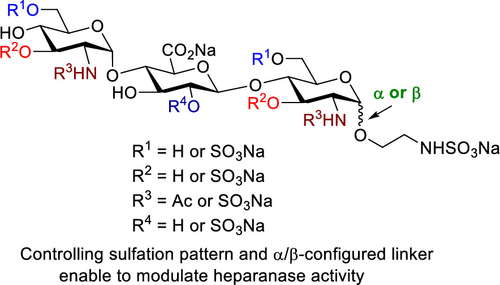当前位置:
X-MOL 学术
›
J. Med. Chem.
›
论文详情
Our official English website, www.x-mol.net, welcomes your
feedback! (Note: you will need to create a separate account there.)
Modulating Heparanase Activity: Tuning Sulfation Pattern and Glycosidic Linkage of Oligosaccharides.
Journal of Medicinal Chemistry ( IF 6.8 ) Pub Date : 2020-04-07 , DOI: 10.1021/acs.jmedchem.0c00156
Sanyong Zhu 1 , Jiayi Li 1 , Ravi S Loka 1 , Zhenfeng Song 2 , Israel Vlodavsky 3 , Kezhong Zhang 2 , Hien M Nguyen 1
Journal of Medicinal Chemistry ( IF 6.8 ) Pub Date : 2020-04-07 , DOI: 10.1021/acs.jmedchem.0c00156
Sanyong Zhu 1 , Jiayi Li 1 , Ravi S Loka 1 , Zhenfeng Song 2 , Israel Vlodavsky 3 , Kezhong Zhang 2 , Hien M Nguyen 1
Affiliation

|
Heparanase cleaves polymeric heparan sulfate (HS) molecules into smaller oligosaccharides, allowing for release of angiogenic growth factors promoting tumor development and autoreactive immune cells to reach the insulin-producing β cells. Interaction of heparanase with HS chains is regulated by specific substrate sulfation sequences. We have synthesized 11 trisaccharides that are highly tunable in structure and sulfation pattern, allowing us to determine how heparanase recognizes HS substrate and selects a favorable cleavage site. Our study shows that (1) N-SO3- at +1 subsite and 6-O-SO3- at -2 subsite of trisaccharides are critical for heparanase recognition, (2) addition of 2-O-SO3- at the -1 subsite and of 3-O-SO3- to GlcN unit is not advantageous, and (3) the anomeric configuration (α or β) at the reducing end is crucial in controlling heparanase activity. Our study also illustrates that the α-trisaccharide having N- and 6-O-SO3- at -2 and +1 subsites inhibited heparanase and was resistant toward hydrolysis.
中文翻译:

调节乙酰肝素酶活性:调节硫酸化模式和寡糖的糖苷键。
乙酰肝素酶将聚合的硫酸乙酰肝素(HS)分子裂解为较小的寡糖,从而释放促血管生成生长因子,从而促进肿瘤的发展,并使自身反应性免疫细胞到达产生胰岛素的β细胞。乙酰肝素酶与HS链的相互作用受特定底物硫酸化序列的调节。我们已经合成了11种在结构和硫酸化模式上高度可调的三糖,使我们能够确定乙酰肝素酶如何识别HS底物并选择有利的切割位点。我们的研究表明(1)三糖的+1位亚基上的N-SO3-和-2位亚基上的6-O-SO3-对乙酰肝素酶识别至关重要,(2)在-1位亚基上添加2-O-SO3- 3-O-SO3-转化为GlcN单元是不利的,(3)还原端的异头构型(α或β)对于控制乙酰肝素酶活性至关重要。我们的研究还表明,在-2和+1亚位处具有N-和6-O-SO3-的α-三糖抑制了乙酰肝素酶并具有抗水解性。
更新日期:2020-04-24
中文翻译:

调节乙酰肝素酶活性:调节硫酸化模式和寡糖的糖苷键。
乙酰肝素酶将聚合的硫酸乙酰肝素(HS)分子裂解为较小的寡糖,从而释放促血管生成生长因子,从而促进肿瘤的发展,并使自身反应性免疫细胞到达产生胰岛素的β细胞。乙酰肝素酶与HS链的相互作用受特定底物硫酸化序列的调节。我们已经合成了11种在结构和硫酸化模式上高度可调的三糖,使我们能够确定乙酰肝素酶如何识别HS底物并选择有利的切割位点。我们的研究表明(1)三糖的+1位亚基上的N-SO3-和-2位亚基上的6-O-SO3-对乙酰肝素酶识别至关重要,(2)在-1位亚基上添加2-O-SO3- 3-O-SO3-转化为GlcN单元是不利的,(3)还原端的异头构型(α或β)对于控制乙酰肝素酶活性至关重要。我们的研究还表明,在-2和+1亚位处具有N-和6-O-SO3-的α-三糖抑制了乙酰肝素酶并具有抗水解性。







































 京公网安备 11010802027423号
京公网安备 11010802027423号